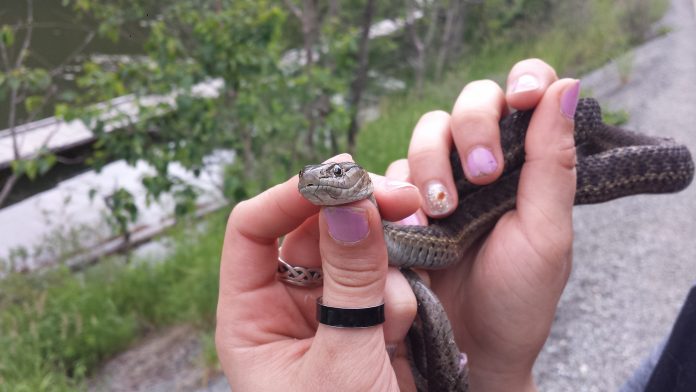Picture this: you’ve just brought home a new puppy. You’re thrilled and snapping all kinds of pictures of your adorable new companion to show your friends and family. But then you start reading the comments. “Aren’t you afraid of it?” “What if it bites you?” “Haven’t you heard about the one that killed those kids? Those are dangerous!” “I’m never coming over to your house again.”
Welcome to the daily life of a reptile keeper. I don’t think I’ve ever gone through a single conversation about my pets without somebody telling me that they should all be killed, or that they’re “unsuitable” for families, or that my three-foot corn snake is going to swallow me whole one day. Misinformation has certainly always been one of the largest obstacles for reptile enthusiasts, leading to cruel practices like the infamous “rattlesnake roundups” in the Midwest and Southern United States, where snakes are killed by the thousands for sport.
Allow me to bust a few popular myths:
The Slimy Snake:
While amphibians (such as toads and salamanders) secrete a protective layer of mucus to keep them hydrated and allow them to breathe properly, snakes are actually dry and smooth to the touch. Their scales are primarily made of keratin — the same thing hair and fingernails are made of.
The Man-Eater:
This one gets me every time. Not only do we not have any species even remotely close to us in Canada and the U.S. that are big enough to try, but the attempt would likely prove fatal for the snake. While some snakes (namely anacondas, African rock pythons, and reticulated pythons, which you won’t find anywhere in Canada outside of zoos and strictly regulated facilities) can grow large enough to eat small deer, it’s rare that they do, simply because of the amount of time large prey takes to digest. Like birds, they will often regurgitate a large meal if they are threatened, and that process is very damaging and sometimes fatal on its own. When they do eat large prey, they are essentially “stuck” until they finish digesting — in a couple weeks!
I Was Chased by a Snake!
Not exactly. A typical snake encounter is simply hearing them slither away because they heard you coming. Save for a handful of species, every snake you encounter in the wild will run away if given the opportunity — the same as almost any other wild animal. In some cases, both of you with happen to choose the same escape path, leading to the feeling of being chased — and the snake probably feels just as freaked out about that as you! If you corner them, or if they feel threatened enough, they may posture and strike at you, but if you simply back up and walk away, you’ll see them hightail it out of there as fast as they can. If you don’t want to get bitten, don’t bother them. Walk away. Easy.
Venomous Bites:
The likelihood of being bitten by a venomous snake in Canada is very, very small. Out of over 3,400 species of snakes known, only approximately 30 species are found in Canada (nine in B.C.), and only four of those are venomous. Only one of those four is found in B.C. — the Northern Pacific rattlesnake, whose bites are very rare and usually occur when people try to handle or kill the snakes.
Even if you do beat the odds and get bitten, it isn’t likely to do a lot of harm. According to data from the World Health Organization, less than 0.02 per cent of snake bites result in fatalities.
Lesson? Leave them alone, and they’ll leave you alone.
The Girl-Measuring Python:
Do you see snakes on the Discovery Channel stretching out beside mice to see if they’ll fit? The legend of the snake “measuring” its owners in preparation for an eventual meal is unfortunately popular because of a widespread fear of slithering creatures. If a snake cuddles up to you, it’s more than likely attracted to your body heat. Snakes are cold-blooded, meaning they control their body temperature with external measures — like basking in the sun, or curling up in a warm place.
The 10-Foot Rattlesnake:
There is no 10 foot rattlesnake. In fact, the pictures of “giant snakes” you see in clickbait ads on Facebook are often relying on a technique called ***forced perspective to make an ordinary snake look gigantic. Forced perspective involves holding the object of the picture closer to the camera so that it looks larger in comparison to the background of the photo. Next time you see a “giant rattlesnake” article, take a look at how the person is holding the snake. Is it stretched towards the camera on the end of a stick or a snake hook? They’ve most likely taken a photo of a regular sized snake using forced perspective.
Photos like these are extremely harmful to the reptile community, as they propagate blind fear and misinformation that lead to pet bans, mass killing of native species, and unwarranted discrimination against a terribly misunderstood animal.
Snakes are not the terrible creatures everybody thinks they are. They are not malicious, vengeful, or plotting anyone’s demise. They are not out to get you. In reality, they make wonderful pets — they’re quiet, hypoallergenic, and only need to eat once every two to three weeks due to a slow metabolism. They might not be the pet for everyone, but people need to set aside their misconceptions and biases and learn to not be afraid of things they don’t understand.


